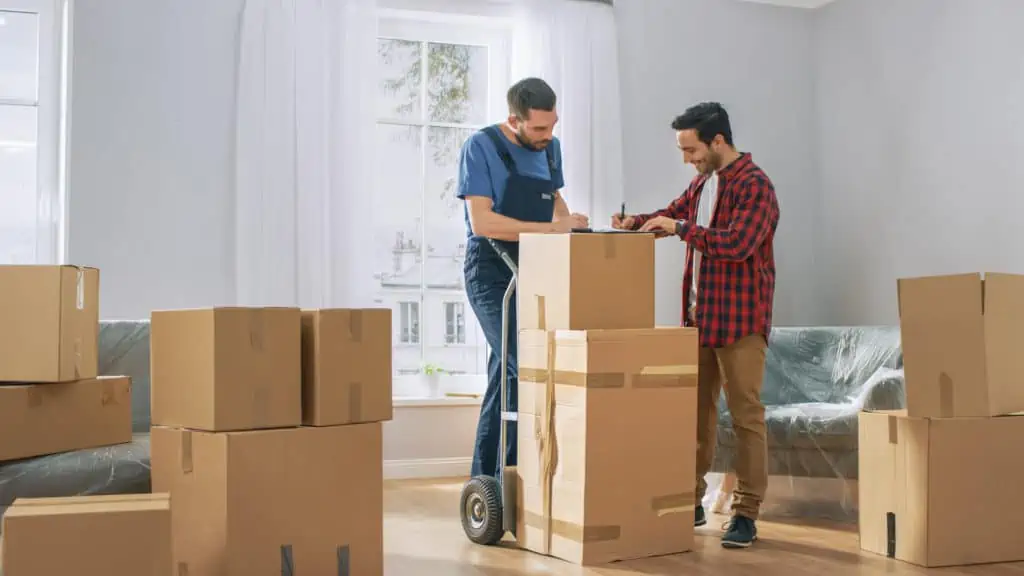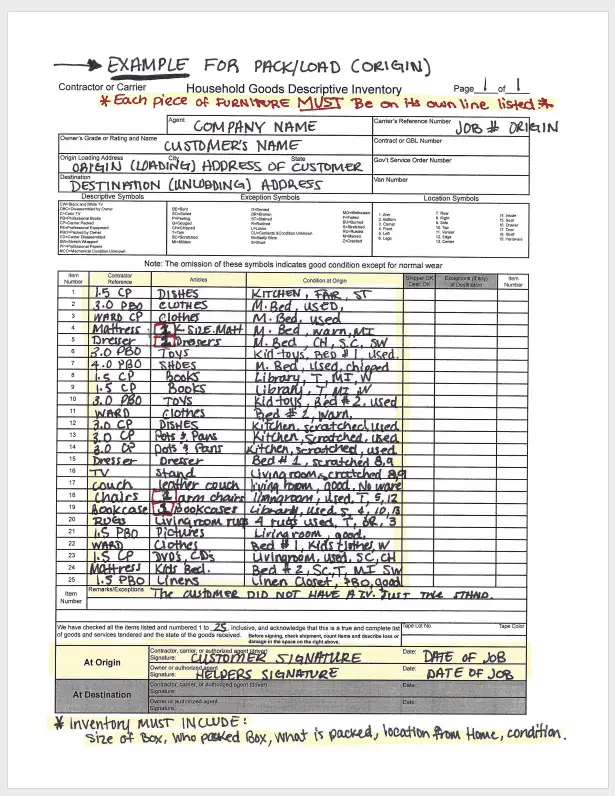After all the stress, money spent, and late nights packing, you’re finally at your new home and ready to unpack and settle in for the last leg of your move. Only, you discover your pricey, one-of-a-kind glass coffee table has been shattered. Or the box filled with family heirlooms is missing. Or while pulling in, the moving truck dings the fence and knocks over your mailbox.
These can be nightmare scenarios, depending on how precious the item is and how expensive it could be to replace. But there are some things you can do once you discover any damage — as well as some things you should try before you move.
If my stuff was broken during a move, what do I do?
Did you hire movers who you suspect damaged or outright broke something? Know that even if money can’t wholly replace the item you lost, there are usually steps you can take to get compensation, both before and immediately after anything gets damaged.
1. Document the damage
For broken or damaged items, the first step is to get plenty of photos.
Those pictures will be very helpful when you file a claim, either with the moving company or with insurance (if you have it). Right after you discover the damage is the best time to do this, but even if some time has passed, any documentation is better than none.
If you’re lucky enough to have any photos of your belongings before the move (which is highly recommended), include those too for a before-and-after. Photos are mandatory for showing exactly what type of damage occurred and the potential cost to repair or replace the item.
My stuff is missing!
But what if after taking stock of everything in your new home, you realize the lamp that’s at the perfect angle for a reading light isn’t there? You’re absolutely sure you packed it, but it’s simply gone.
Obviously, you can’t take photos of something missing. Ideally, if you have one, you should go through your entire moving inventory thoroughly when your movers are finished and still there. Rushing through the process and confirming that everything made it to your destination when that’s not the case will make it much harder to locate a missing item or file a claim.
“…it’s much tougher to deal with moving problems after the fact. Which is why it’s so important to work with a company that’s been pre-vetted.”
If it turns out something truly is missing, your only true recourse is to ask the moving company to track it down. It could have been left behind or delivered to the wrong address. (Ask your old property manager/check your old place too, of course.) Alerting the moving company ASAP is key, since the more time that passes, the higher the chance of it getting lost for good.
(If this isn’t an accident and you think there’s been a crime, read about what to do.)
2. File a claim
Once you’ve taken stock of what’s damaged or missing, it’s time to inform the moving company of what happened.
Below is the contact information for a number of national moving companies and where you should file a claim for your lost or broken items.
How To File a Claim With National Moving Companies:
- Allied Van Lines: Fill out their online claim form. You can also e-mail claimstrace@alliedvan.com or call (800) 470-2851 to discuss a missing item or coverage prior to filing a claim
- Arpin Van Lines: If you need information or help filing a claim, call (855) 405-9293 and dial option 3 to speak to a claims representative or email claims@wvlcorp.com. You can also file a claim online
- Atlas: You can file a claim directly through the Atlas® Customer Portal. If you need help, call (800) 638-9797 (ext. 2846# or 2850#)
- Bekins Van Lines: Claims can be filed online. For assistance, call (833) 425-4982 and dial option “3”, or email claims@wvlcorp.com
- HireAHelper: You can fill out their online claim form. There’s also the option of calling (800) 995-5003 or emailing customer-support@hireahelper.com
- Mayflower: Most claims can be submitted online. However, if your move took place within the state of Texas, call (800) 325-9970 to get the appropriate form
- Moving Help (U-Haul): You can contact them or fill out an Issue Resolution request online. You’re also able to file a claim directly under the subcategory “Safeload”
- North American Van Lines: File a claim online, or call (800) 348-3746 or email claims@navl.com for help. Note that intra-Texas moves use a separate claims form and it must be filed within 90 days of delivery
- U-Pack: Email moving@upack.com with your name and reference number, and they’ll send you a claim form to complete and submit
- United Van Lines: Most claims can be filed online. For intra-Texas moves, call (800) 325-9970 for assistance
- Wheaton World Wide Moving: Claims can be filed online. For help, call (855) 284-4011 and dial option 3, or email claims@wvlcorp.com
How To File a Claim With Local Moving Companies:
Unfortunately, there is no formal process for damages caused by a local moving company that you hire directly. That said, many local moving companies will offer to help or partially pay for damages, but it’s entirely up to them to work with their customers on a case-by-case basis.
However, if you hire a local moving company through an online mover marketplace like HireAHelper, you will be covered in all instances of damages. HireAHelper automatically steps in to mediate and get your money back.
- HireAHelper: You can call (800) 995-5003, or email customer-support@hireahelper.com. They are available seven days a week, so you should always be able to get ahold of somebody to help.
3. File a third-party complaint (maybe)
If you submitted a claim but the moving company is not responding, or you feel that they’re not taking enough responsibility, you should file a complaint with a third-party organization.
The first organization to contact is the Federal Motor Carrier Safety Administration (FMCSA). This is a division of the U.S. Department of Transportation (DOT). You can file a complaint online for issues such as lost or damaged items, issues with the company’s license or insurance, overcharges and more.
Once you file a complaint, the movers have 30 days to acknowledge it, plus another 120 days to dispute or resolve it. (Not ideal, but it’s something.)
See prices for movers by the hour – instantly.
Read real customer reviews.
Easily book your help online.
You can also file a complaint with the Better Business Bureau. After filing your complaint, the BBB processes it within two business days. The business then has 14 days to respond from the date you filed. Complaints are usually closed within 30 days. However, if the business fails to respond, it can negatively impact its BBB rating.
If you think something was actually stolen or intentionally damaged, you should contact your local police department and file a report.
4. You can also seek arbitration from the government
Another option you have if a claim isn’t being handled properly is arbitration. It’s a form of dispute resolution that allows everyone to avoid going to court. Interstate movers are required to participate in an arbitration program, such as the one offered by the FMCSA. (Click here to get started.)
What about moving insurance?
If you’re worried about any possessions being damaged, but you haven’t even hired movers yet, insurance is a possibility. Unfortunately, for reasons all too familiar, you probably won’t be able to rely on your homeowner’s or renter’s insurance for items lost or damaged while moving. But you’re not necessarily out of luck.
Hired movers are generally responsible for the items they’re transporting. However, if you move across state lines, all moving companies are federally required (that means in every single state) to offer two insurance options:
- Full value protection: This means the moving company is responsible for covering the total replacement value of any possessions that are lost or damaged. They can opt to repair or replace the damaged item, or give you cash. This is the most comprehensive coverage, which means it’s also the most expensive.
- Released value protection: It’s free… but you get what you pay for. It provides up to $0.60 per pound of an item that’s lost or damaged. So if your 40 lb. flat-screen TV worth $1,000 gets cracked, the most you would be compensated is about $24.
- Third-party liability insurance: Some movers may offer this separately. It costs extra but will cover any damages beyond the released value coverage, up to the policy’s limits.
Hiring movers directly means you’re responsible for most of this research and decision-making. But companies such as HireAHelper that curate and help you find the best movers also help you with all the moving insurance stuff.
See prices for movers by the hour—instantly.
Read real customer reviews.
Easily book your help online.
On top of full value protection, HireAHelper automatically offers a $1,000 Safety Guarantee with every order for free, with plenty of other options to upgrade. After curating thousands and thousands of moves, HireAHelper knows 
Again, if you have no insurance, you should still be able to receive some kind of compensation, as long as you’re working with a licensed and reputable moving company. (It’s important to check before hiring anyone!)
What happens after filing a claim with the insurance company?
In many cases, you have up to nine months to file a claim with the company. But again, the faster you file, the sooner you’ll resolve the issue.
After you file the claim (usually this is done online but possibly over the phone):
- The company will respond to acknowledge they received it (generally within 30 days)
- They will investigate the situation and eventually either offer compensation or deny the claim
Keep in mind there are some situations when the insurance company isn’t responsible for covering your damages. For example, if you choose to pack your own items yourself and something breaks, that’s typically on you, not the movers. The same is true if you pack anything that’s perishable, hazardous, or highly valuable without notifying the movers. Damage from natural disasters is also usually not covered.
Hiring Reputable Movers Is Important
You might assume that if you hire a professional moving company, they have all the necessary processes in place to handle damages. But the truth is a lot of local moving companies don’t actually have insurance or customer service in a traditional sense. And scarily enough, in some cases, you could be dealing with a moving scam. (Click here to learn more if you think you’re being scammed.)
Of course, it’s much tougher to deal with moving problems after the fact. This is why it’s so important to work with a company that’s been pre-vetted. And that’s exactly why HireAHelper exists — we built a national database of reputable movers who not only pass our strict requirements to be listed, but also get publically rated by verfied customers to hold them accountable.





 #1. The nicer the furniture, the more likely you’ll damage it.
#1. The nicer the furniture, the more likely you’ll damage it.






